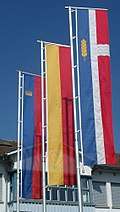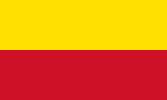Flag of Liechtenstein
The flag of Liechtenstein (German: Flagge Liechtensteins) is the national flag of the Principality of Liechtenstein. It consists of two horizontal blue and red bands charged with a gold crown in the canton. In use since 1764 and officially enshrined into the nation's constitution in 1921, it has been the flag of the principality since that year. The crown was added to the flag in 1937 after the country found out at the Summer Olympics held the previous year that their flag was identical to the civil flag of Haiti.
 | |
| Use | Civil and state flag |
|---|---|
| Proportion | 3:5 |
| Adopted | June 30, 1982 |
| Design | A horizontal bicolour of blue and red, charged with a gold crown in the canton |
History

Liechtenstein was formed in 1719 as a principality within the Holy Roman Empire, and gained complete independence in 1866.[1] Within this period, the colours blue and red were selected to feature on the flag, instead of the gold and red on the coat of arms that would have customarily been employed instead. These new livery colours were first utilized by Prince Joseph Wenzel I in 1764.[2]
A new constitution for the Principality was formulated and proclaimed in October 1921.[2][3] It made the blue and red banner the national flag by granting it "official status".[2] Fifteen years later, during the 1936 Summer Olympics, the country came to the realization that its flag was identical to the flag of Haiti, even though Haiti did not participate in the Olympics that year. Because of this finding, the government added the prince's crown to the canton.[2][4][5] This change served two purposes – to signify Liechtenstein's position as a principality, and to distinguish its flag from Haiti's.[4][6] This modified design was adopted on June 24, 1937.[6]
Design
Construction
.svg.png)
 3:5
3:5 Pennant
Pennant Vertical
Vertical
Symbolism
The colors and symbols of the flag carry cultural, political, and regional meanings. The blue represents the sky, while red alludes to the "evening fires" that are lit inside houses throughout the country.[2] The crown – whose colour is disputed – epitomizes the "unity of the people and their prince."[2] While The World Factbook and Reuters describe it as gold in colour,[4][5] other sources – such as Whitney Smith in the Encyclopædia Britannica – describe it as yellow.[2][6]
Legal issues
In February 2004, the Financial Intelligence Unit (FIU) of Liechtenstein called for the capture of a Falcon 50 private jet that was owned by the former regime of Saddam Hussein and kept in Amman, Jordan. They sought this action because the plane flew the flag of Liechtenstein and had a registration number from Switzerland, which keeps the civil aviation records of the Principality. This was carried out shortly afterwards in order to comply with United Nations Security Council Resolution 1483.[7] After being transported to Basel and revamped entirely, the Liechtensteiner government returned the plane to the new government of Iraq on December 5, 2005. This marked the first Iraqi aircraft seized under UN sanctions to be given back to the country.[8]
Government flags
 Standard of the Prince of Liechtenstein
Standard of the Prince of Liechtenstein.svg.png) Standard of the Government of Liechtenstein
Standard of the Government of Liechtenstein Banner of the Princely House of Liechtenstein
Banner of the Princely House of Liechtenstein Pennant
Pennant Vertical
Vertical
Flags of municipalities
The eleven municipalities each have their own flag.
Historical flags
| Flag | Duration | Use | Description |
|---|---|---|---|
.svg.png) | 1719–1852 | Flag of the Principality of Liechtenstein | Two horizontal gold and red bands at 3:5 proportions |
.svg.png) | 1852–1921 | Flag of the Principality of Liechtenstein | Two vertical blue and red bands at 3:5 proportions |
.svg.png) | 1921–1937 | Flag of the Principality of Liechtenstein | Two horizontal blue and red bands at 3:5 proportions |
.svg.png) | 1937–1982 | Flag of the Principality of Liechtenstein | Two horizontal blue and red bands at 3:5 proportions, and princely crown in top-left corner |
References
- "Liechtenstein profile". BBC News. BBC. Retrieved June 26, 2014.
- Smith, Whitney (July 17, 2013). "Flag of Liechtenstein". Encyclopædia Britannica. Encyclopædia Britannica, Inc. Retrieved June 26, 2014. (subscription required)
- "History of Liechtenstein". Lonely Planet. Retrieved June 26, 2014.
- "Liechtenstein". The World Factbook. CIA. Retrieved June 26, 2014.
- Rainey, Venetia (July 24, 2012). "Flag bearing: a potted history". Reuters. Retrieved June 26, 2014.
- Kindersley, Dorling (November 3, 2008). Complete Flags of the World. Dorling Kindersley Ltd. p. 148. ISBN 9781405338615. Retrieved June 26, 2014.
- "Leichtenstein [sic] orders seizure of Saddam jet in Amman". Agence France-Presse. February 26, 2004. Retrieved June 26, 2014. (subscription required)
- "Saddam plane handed over". Cayman Compass. Associated Press. December 5, 2005. Archived from the original on March 3, 2016. Retrieved June 26, 2014.
External links
| Wikimedia Commons has media related to Flags of Liechtenstein. |
- Liechtenstein at Flags of the World
- Original Law text (in German)

